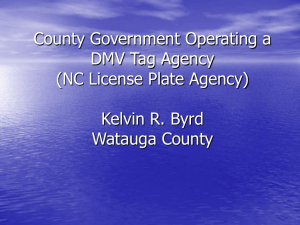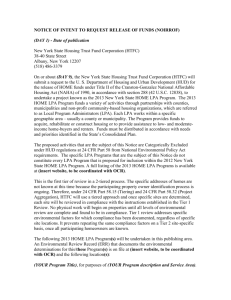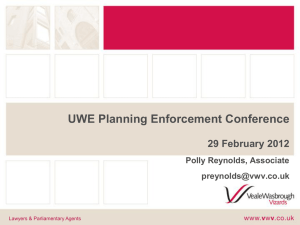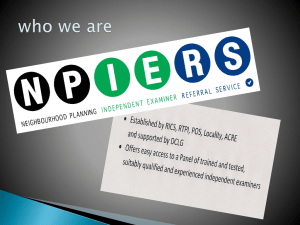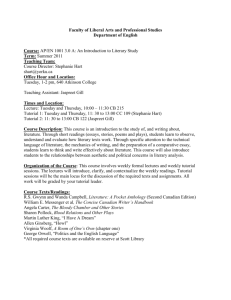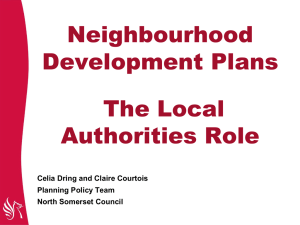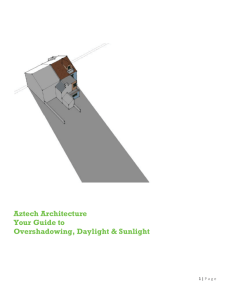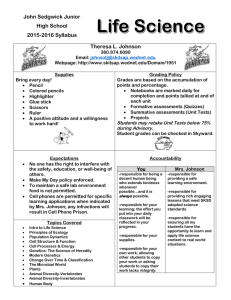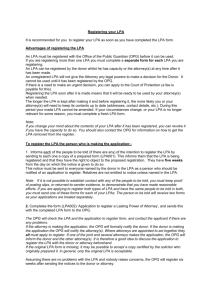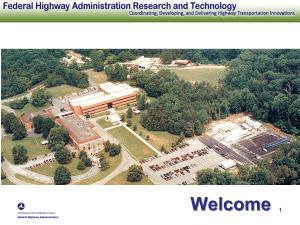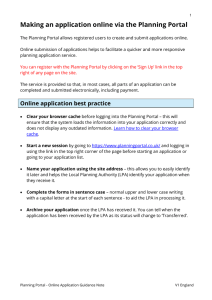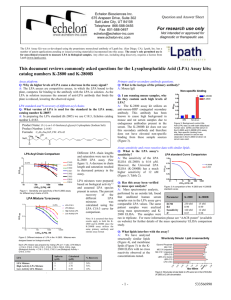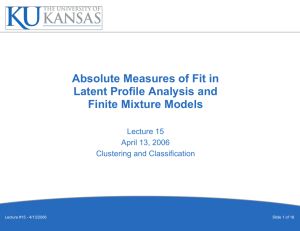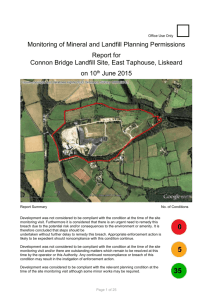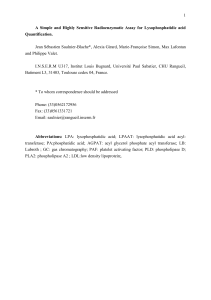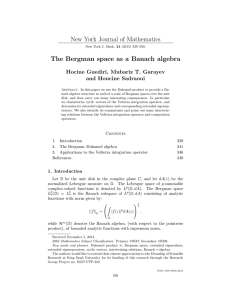Jim Redwood Head of Planning South Downs
advertisement
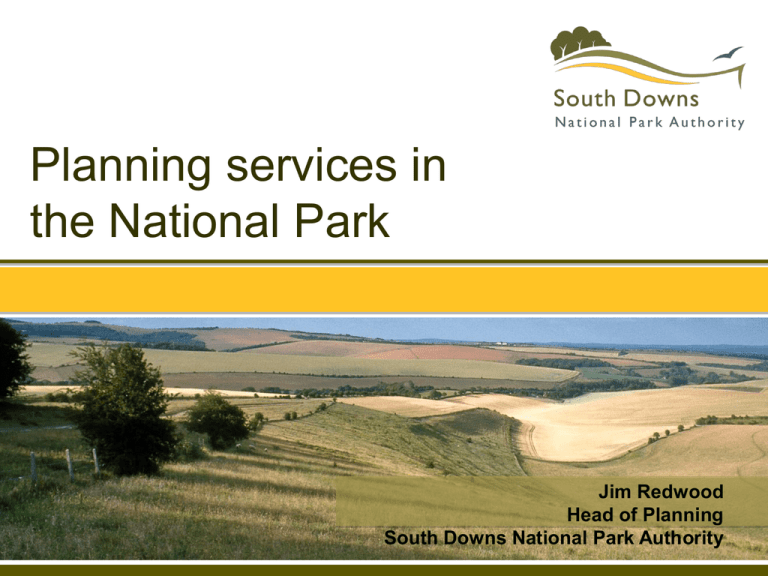
Planning services in the National Park Jim Redwood Head of Planning South Downs National Park Authority 1st April 2011 From 1st April 2011 the SDNPA is the sole planning authority for the South Downs National Park: -responsible for all planning decisions -responsible for all planning policy -responsible for LDFs, enforcement, minerals and waste Role of the National Park Purposes: • Conserve and enhance the natural beauty, wildlife and cultural heritage of the area • Promote opportunities for the understanding and enjoyment of the park’s special qualities by the public Authority Duty: • To seek to foster the economic and social well-being of the communities within the National Park Statistics • c4,000 planning applications/year – other NPAs in range 39 (Northumberland)-1,000 (NFNP) • 8th largest LPA in 2008/9 – cf Kirklees (3,700) • Only 61 ‘majors’ in 2008/9 • 15 LAs/LDFs Delegation • The SDNPA is working in partnership with all 15 Local Planning Authorities to provide planning services for the National Park from 1st April 2011- ‘delegation’ • Delegation is an agency agreement under s101 of the 1972 Local Government Act – cf Highways agency agreements – a service provided by one LA for another • SDNPA will pay LAs for the services they provide Delegation • Agreement to agree’ – provides a legal basis for LPAs to provide planning service for SDNPA from 1/4/11 to 31/3/12 • Bi-lateral s101agreements being negotiated with all 15 LPAs – final drafts now under discussion – may not be in place by1/4/11 Duration and Review of S101 agreements • Three year agreement • Rolling 12 month notice to quit • Review at least annually • Performance framework How will it work? • All applications will be ‘processed’ through current LA systems -Validation -Registration -Consultation • Key documents and correspondence ‘badged’ with joint SDNPA/LPA identity The official branding for the SDNPA documents (Lewes example) Example 1 (Arun District Council) – no SDNPA logo, but use of SDNPA strapline Example 2 (Horsham District Council) – use of SDNPA logo and strapline on existing Horsham headed paper Who Does What : Significance • Of the c4,000 applications/year we only expect up to 150 to be determined by the SDNPA - most (about 98%) applications will continue to be LPA determined. • SDNPA will determine applications of ‘significance’ to the SDNP Major / Minor split: Minors (less than 10 dwellings, 1000 sq m commercial floorspace or sites less than 0.5 Ha) most likely to be delegated to the LPAs. Majors (10 dwellings, 1000 sq m commercial floorspace or sites of 0.5 Ha or more) likely to be for NPA determination, but: ‘Minor’ Development which might be Significant • 3 or more dwellings on the edge of a small village or settlement • Tourism, leisure and visitor accommodation schemes • Individual energy schemes outside existing settlements • Smaller scale infrastructure projects outside existing settlements • Proposals to alter the operation of some minerals and waste facilities • Telecommunications proposals with visual impacts on SDNP • Proposals for lighting outside existing settlements • Smaller scale development which may have cumulative adverse impact on SDNP ‘Major’ Developments not likely to be Significant • Major Residential schemes(10 – 29 dwellings) that are proposed within existing towns and that are considered to have less significance for National Park purposes. • Major commercial schemes (1,000 – 2,999 square metres floor space) that are proposed within existing commercial centres within towns and some smaller settlements and that are considered to have less significance for National Park purposes. Call-in Procedures • Significant applications to be identified as soon as possible – eg at pre-application stage • Applications can be recovered at almost any stage if they are ‘significant’ – but not just because there’s a big lobby • Applications on committee agendas must be identified before the meeting for call-in to apply, if officers recommendation is overturned Who/where do I go to? • Your first point of contact should be with your Local Authority as usual, unless it is clear, or has already been agreed that the SDNPA will determine it • The Local Authority will give initial advice on who will determine the application – consulting the SDNPA (Link Officer) as necessary Who/where do I go to? • The SDNPA/Link Officer may be involved in pre-application discussions if appropriate • If it is clear that the SDNPA will determine it, pre-application discussions will be with the SDNPA direct Enforcement Protocol • LPA is always first port of call for all enforcement activity • Current enforcement resources continue to apply • No prior requirement to consult SDNPA on enforcement matters in all urgent cases, unless costs are possible. • SDNPA advice & influence through Link Officers • SDNPA has limited supplementary enforcement resources S106 Agreements / CIL • Current LPA arrangements and policies apply • All Section106 funding to be held by SDNPA until used to fund the scheme it was collected for. • S106 agreement protocol to be agreed Specialist Services • Current resources continue to be used – Conservation Officers, Arboricultural Officers, Agricultural Estate Advisers, Design Officers, Landscape Advisers, Archaeologists, Ecologists etc. • SDNPA has 2 Historic Buildings Officer and a National Park Design Officer • SDNPA has additional complementary specialist advice to supplement/signpost local specialist advisers Appeals • Appeals against LPA decisions to be handled by LPA – SDNPA will need to be consulted and possibly involved. • Appeals against SDNPA decisions to be handled by SDNPA. Link Officer Role 4 Link Officers: Hampshire - Nat Belderson Chichester – Natalie Fellows Rest of W Sussex – Mike Bleakley East Sussex, including Brighton and Hove – Roy Little Link Officer Role Interface between LA and SDNPA: -Weekly Lists of applications -Pre-application discussion and enquiries. -Advice and guidance on SDNPA approach -Call-in advice and provisions -Enforcement liaison -Appeal procedure liaison -Routine point of contact on other emerging issues Policy • Current policies continue to apply • Joint Core Strategy work under discussion with LPAs – need to prepare LDS by June 2011 • Early SPD to review inherited saved local plan policies and AONB policies Guiding Principles The Authority’s role should be to: • Champion the South Downs providing strategic leadership • Bring people together and act as a coordinator • Influence policy making and be a source of expertise • Deliver flagship projects, drawing down external funding • Engage directly with communities, land managers and visitors • Encourage volunteering to help strengthen communities • Build partnerships to tackle the challenges facing the South Downs – e.g. climate change, development pressures Questions?



